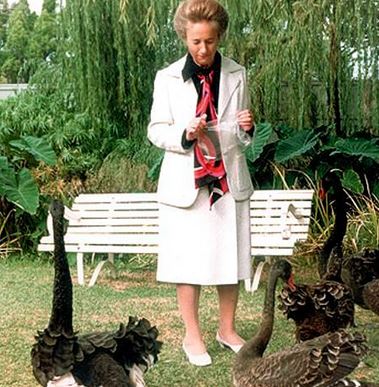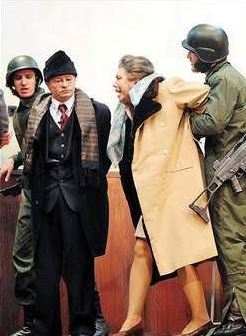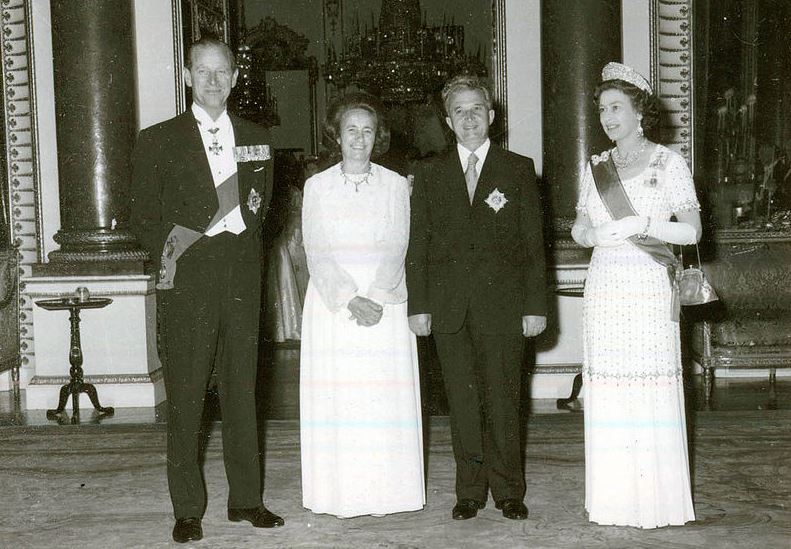Tony Thomas The Original Power Couple Part one
Nicolae Ceaucescu and wife Elena were dispatched with extreme prejudice when the Romania people finally rid themselves of a duo so brazen in their greed and tyranny no writer of fiction would have dared invent them. It’s quite a story, not least the gullibility of leaders in the West.
Britain’s Islam-friendly politicians, led by London’s Muslim Mayor Sadiq Khan, are campaigning to cancel Prime Minister Theresa May’s invitation to President Trump for a State visit in 2018. Britain has not always been so fussy about who gets a State reception. In the wake of a trip to Bucharest I’ve been researching the Communist-era dictatorship of Nicolae Ceaucescu and his wife, Elena (left).
They were invited to Britain by Labor Prime Minister James Callaghan in 1978. Callaghan pimped a reluctant Queen Elizabeth to meet them at Victoria Station, and put them up in Buckingham Palace. Ceaucescu even got a ride with Her Majesty in the State landau. They were accompanied by bodyguard General Ion Pacepa, who defected to the West a month later, and a clatter of Household Regiment cavalry. The Queen later described the visit as “the worst three days of my life”. She was required, among other indignities, to award him the Knight Grand Cross of the Order of the Bath, subsequently revoked in 1989.
Ceaucescu came ostensibly “to make firm friends among Western nations”, as the newsreels put it, and to sign a £200-million deal to buy several British Aerospace BAC 1-11 airliners (predecessor to DC9s and B737s) and build scores more in Romania under licence for export to China and the Third World. His actual goal was to open British doors for Romanian secret service men, doubling as technicians, to steal airline, Rolls Royce engine and Harrier jump-jet technology, to be on-sold to Moscow notwithstanding Ceaucescu’s vaunted hostility to Brezhnev.
The airliner deal turned into farce. An entire assembly line was air-freighted to Romania to make six BAC 1-11s a year. At its peak the Romanians had 4400 skilled workers on the job. But the plane was already obsolete and actual production was no more than one a year. The two nearly finished planes were left to rot and rust after Ceaucescu’s overthrow. He also defaulted on the hard currency required and sought to pay in barter. The first shipload of Romanian strawberries was rotten by the time it reached the wharf.
In Bucharest I joined a tour of the Ceaucescus’ Primaverii or “Spring” residential palace, all of us especially slack-jawed at the indoor tropical garden built on top of a swimming pool, with infra-red heating equivalent to power 100 normal apartments. The pool’s rear walls comprise a million-piece mosaic of pretty fishes that took artists two years to complete. This was just one of his five official residences, 39 guest houses, 21 exclusive apartments in embassies, nine planes, three helicopters and three presidential trains. Plus the couple had a hospital reserved for themselves alone.
In the palace’s bedroom quarters was a silk-upholstered Louis XV style sofa. “Guess who this sofa was for?” asked the guide. Nobody knew. “For the two Labradors that Queen Elizabeth gave the Ceaucescus,” the guide said.
He was fairly right. During the official visit to London, Liberal Party leader David Steel gave them one Labrador pup. If the Queen gave the other one, it was kept quiet and unofficial. Ceaucescu decided that as the pups were British, his London ambassador should buy dog biscuits from Sainsbury’s weekly for delivery via the diplomatic bag. As a dog lover, it grieves me that during the Christmas 1989 overthrow of the Ceaucescus, the two Labs were clubbed to death. (There’s a sanitised version that they went into a fatal decline after their owners were felled).
Give it to the Royals, those smiles are almost convincing.
The defector Ion Mihai Pacepashocked Western intelligence agencies by disclosing that Romania’s “independent” stance within the Warsaw Pact was largely disinformation to win sympathy and help Romania acquire trade credits and otherwise-forbidden industrial and military technology for itself and Moscow. (To some extent Ceaucescu did some genuine brinkmanship, notably when he condemned the Soviet’s 1968 invasion of Czechoslovakia.)
Ceaucescu would set Western companies drooling with the hope of big orders, encouraging them to pass over swathes of technical data only to welsh on his side of the bargain. A classic case centred on Romania’s order for Canadian CANDU civil nuclear reactors, which began in 1969 with the lure of 20 possible purchases and ended in 1982 with the Romanians in possession of three quarters of CANDU technology while, in the end, buying only Soviet reactors. In addition, they had conned the Canadians into giving them a $US1billion line of hard-currency credit, which Ceaucescu from the outset diverted towards unrelated purchases.
Pacepa, who’d been in charge of technology, described how half of Romania’s modern industry had been built using stolen blueprints and technology for everything from petrochemicals, films, radial tyres and dyes to pharmaceuticals, rolling mills, machine tools and diesel engines.
A classic technique was to dangle a large order before half a dozen international bidders and let the negotiations drag on. In the process, bidders would progressively reveal more detailed specifications – for example, a French contender to supply a petrochemical plant brought to Bucharest documentation of a complete plant it had just sold to another buyer. It was child’s play for the secret police to get the documents photographed.
Ceaucescu was the first Communist leader invited to the inner sanctums of Texas Instruments, at a time when TI was the world leader in defence-essential microcircuits. Back home, he bragged, “What has America got out of it? Shit, nothing but shit.” He told his technology gatherers they were “soldiers without guns”, keeping “a broad smile on your face as you look towards the enemy. Let him believe that we like him. Smile with your mouth, and hit him with your brains , with your cleverness.”
It worked a treat. The Queen, reading from her UK government script, praised the Ceausescus for their “heroic struggle” and said how much Britain had been impressed “by the resolute stand you have taken to sustain the independence of Romania”. Pope Paul VI in 1973 also weighed in: “We ask heaven to bless your activity, which we follow with great interest, and we ask you to consider us humble supporters of your policies of independence and sovereignty, which you are executing with such consistency.”
Western leaders, led by de Gaulle, flocked to Bucharest for state visits. President Nixon and the Ceaucescus made two reciprocal trips. President Ford received the couple, himself visiting Bucharest only three weeks after his inauguration. Thanks to Romanian disinformation, they all imagined that Ceaucescu was ‘their’ sort of Communist, one who deserved support with industry know-how. President Carter orated that Ceaucescu “has not only brought tremendous progress  to Romania, but also has taken on a role of leadership in the entire international community.” Bamboozled by more Romanian disinformation, Carter even credited Ceaucescu with helping to create the Helsinki Human Rights declaration – a leader who used his murderous thugs, including Carlos the Jackal and outsourced Arab gunmen, to terrorise dissidents at home and abroad.
to Romania, but also has taken on a role of leadership in the entire international community.” Bamboozled by more Romanian disinformation, Carter even credited Ceaucescu with helping to create the Helsinki Human Rights declaration – a leader who used his murderous thugs, including Carlos the Jackal and outsourced Arab gunmen, to terrorise dissidents at home and abroad.
The Queensland and WA premiers, Bjelke-Petersen and Brian Burke, along with our coal and iron ore producers, fell for the notion that Romania was a prize market and entre to the Eastern bloc. Burke and iron ore magnate Lang Hancock flew a large business party to meet Ceaucescu in the port of Constanta in mid-1987, seeing Romania as a gateway to sales into Eastern Europe. Ceaucescu was non-committal and the party was shocked at the low quality of Romanian railway wagons that he offered as barter. Nonetheless the Ceaucescus made a trade visit to Canberra, Brisbane and Perth in April 1988, with Elena (above) quite taken with our unique black swans.
The Romanian president was fearful of assassination, and at one state dinner where Queenslanders engaged in a bit of back-slapping in the foyer, his security squad pulled out their guns. His food-tasters sampled each plate. Ceaucescu’s habit with unwanted morsels was to drop them surreptitiously to the floor and then kick them far down the table.
At Brisbane’s Government House, his bizarre requirements included the binding of his toilet seats with soft, sterilised medical bandages. His party to Australia came with his steamer trunks of sterilized pillows, linen, towels, bathrobes, mats and rugs, all items in sealed vacuum bags. He used a portable laboratory to chemically analyse food and brought his own fare in special containers. Radiation, chemical and biological detectors were installed and sentries manned every entrance to the couple’s suites.
He feared poison powders on his clothes and personal items, especially after rumors that the CIA had attempted that method on Fidel Castro. Hence a dedicated tailoring workshop provided him with 365 fresh suits and shoes per year, with used outfits stamped in colored ink and burnt in a furnace.[1] He also disliked being touched and used alcohol disinfectant after every handshake, including when he shook hands with the Queen. His wife and Prime Minister, Elena, used all state visits to extort costly presents from their hosts. Before their London visit in 1978, according to Pacepa, she daydreamed about the jewels she would acquire and “take a look at in the privacy of Buckingham Palace.”
On a West German visit, the couple came away with a Mercedes 600 limo for him, a 450 series for her, a coupe for daughter Zoia, and two Audis for their playboy son, Nicu. Plus they got an 11-metre mobile home and office. None were ever used.
Elena’s most breathtaking grab came in 1975 when she grasped for the luxury yacht owned by King Hussein of Jordan. The king had welcomed them aboard, and Elena told Pacepa, privately and tearfully, “I want that yacht. I won’t leave without it.” The king explained next morning that he had already given it to his wife Alia as a love token. To end the stalemate, he built her a copy in the US. Christened “Friendship”, the yacht was delivered 15 months later, but she never set foot on it. For their US visit to President Carter in 1978, she set her sights on a full-length mink coat and cape. Carter declined, incurring her hatred as “President Peanut” because he offered only a copy of his book, Why Not the Best?
From hopeful Fifth Avenue jewelers, she acquired a dozen boxes of jewellery, each then worth around USD20,000, which she took back to Bucharest for selection and return. Her ruse was to ‘forget’ about them. It is not clear if the jewelers were ever paid from the Ceaucescus’ USD400m slush fund, or if Fifth Avenue had to write off the expense.[2] She was an enthusiastic promoter of her husband’s 1966 scheme to boost Romania’s population by banning abortion and contraception and generating four children per couple – couples who could barely afford one child. Women were ordered to undergo monthly checks by gynaecologists (dubbed the Menstrual Police) and any pregnancies discovered were tracked through to birth. Hospitals were monitored by secret police and women seeking abortions risked years in gaol along with their helpers. Back-alley abortions proliferated all the same, with mortality reaching ten times the level of neighboring countries. Mothers abandoned babies to horrific state orphanages, where thousands of infants were infected with AIDS. By 1989 abandoned children totaled 170,000, when emerging images of their fetid, chained and loveless conditions shocked the West. Elena had tried to encourage adoptions by lying that she adopted her own first child, Valentin, as an example to the nation. Her arithmetic let her down as Valentin was born in 1948 when Elena was a nobody incapable of inspiring anyone, let alone the nation.
Romania’s first lady — and prime minister, don’t forget — modelled her dynastic ambitions on Isabel Peron, then President of Argentina. “If a whore from a Caracas night club could do it, why not a woman of science?” she asked. A woman of science indeed! She finished her education at the fourth grade. As a teenager, one of her jobs was as a menial in a chemistry lab, where she coveted the scientists’ god-like status. In power, she organized the ghost-writing of her 1975 PhD thesis on “The stereo specific polymerization of the isoprene on the stabilization of synthetic rubber.” Such erudition elevated her to the Romanian Academy, and a chemical institute was built especially for her.
She attended scientific conferences, with Romanian scientists as her translators. They ensured that her ignorance went un-noticed. But on one occasion she read one of her own papers. That seemed safe, but she read “CO2” as “koh-doi” (English-sounding: “Cohtwo”), not knowing to pronounce the “C” and the “O” separately, and inadvertently punning in Romanian to mean a “big tail”. Nevertheless she collected a total of eight foreign scientific honors, including one “earned” by badgering her US hosts for an honorary degree from leading universities. Her efforts ended in a fit of outrage when she offered no more than honorary membership of the Illinois Academy of Science. In Manila the refusal of the main university to honor her threatened a diplomatic crisis, but President Marcos, with a large donation, changed the university’s mind.
 In London Elena demanded membership of the Royal Society. What she got was an honorary doctorate from the Central London Polytechnical Institute and membership of the Royal Institute for Chemistry. While the Royal Society has lately become a sanctuary and pulpit for catastropharian global warmists, it is re-assuring to know that, once upon a time, standards were upheld. Her ambitions stretched to a Nobel Prize for Chemistry, involving her supposed discoveries and advances in science’s war on cancer.[3] To pave the way she had secret police specialists to amass a portfolio of leading-edge Western research. She took charge of the Romanian Patent Office, and organized for the research to be backdated and patented in her name.
In London Elena demanded membership of the Royal Society. What she got was an honorary doctorate from the Central London Polytechnical Institute and membership of the Royal Institute for Chemistry. While the Royal Society has lately become a sanctuary and pulpit for catastropharian global warmists, it is re-assuring to know that, once upon a time, standards were upheld. Her ambitions stretched to a Nobel Prize for Chemistry, involving her supposed discoveries and advances in science’s war on cancer.[3] To pave the way she had secret police specialists to amass a portfolio of leading-edge Western research. She took charge of the Romanian Patent Office, and organized for the research to be backdated and patented in her name.
Elena kept up her scientific charade to the last hour of her life. She was tried in Targoviste by a kangaroo court, and was asked:
“Tell me what you know about the Timosaura genocide, or do you only think about polymers?”
– “You call it a genocide…for 36 deaths?”
“Who writes the scientific papers for you, Elena?
“You should be ashamed of yourself, I am a member of the Academy of Sciences. One cannot speak to me like that, to me.”
Her finest moment was her last – thats her and hubby (above) being led to their executions — with telling her executioners , ‘If you are going to kill us, then out of respect for our love for each other, don’t kill him and make me watch. At least let me die along with my husband.’ The general ordered: “Take her to the wall with him.”
Minutes later, bursts from three AK47s riddled the evil couple. The final indignity was that the helicopter returning to Bucharest was so crowded that one of the firing squad had to use the dictator’s corpse as his seat.
Tony Thomas’s book of essays, That’s Debatable – 60 Years in Print, is available here
_______________________________________________
[2] Ceaucescu built this personal fund largely from selling exit permits for Romanian Jews and ethnic Germans. An individual could be priced at up to USD250,000.
[3] She also wanted herself and her husband to win a Nobel Peace Prize for their efforts to mediate between the PLO and the Israelis. In reality Romanian was supporting the global export of PLO terror.
Comments are closed.

